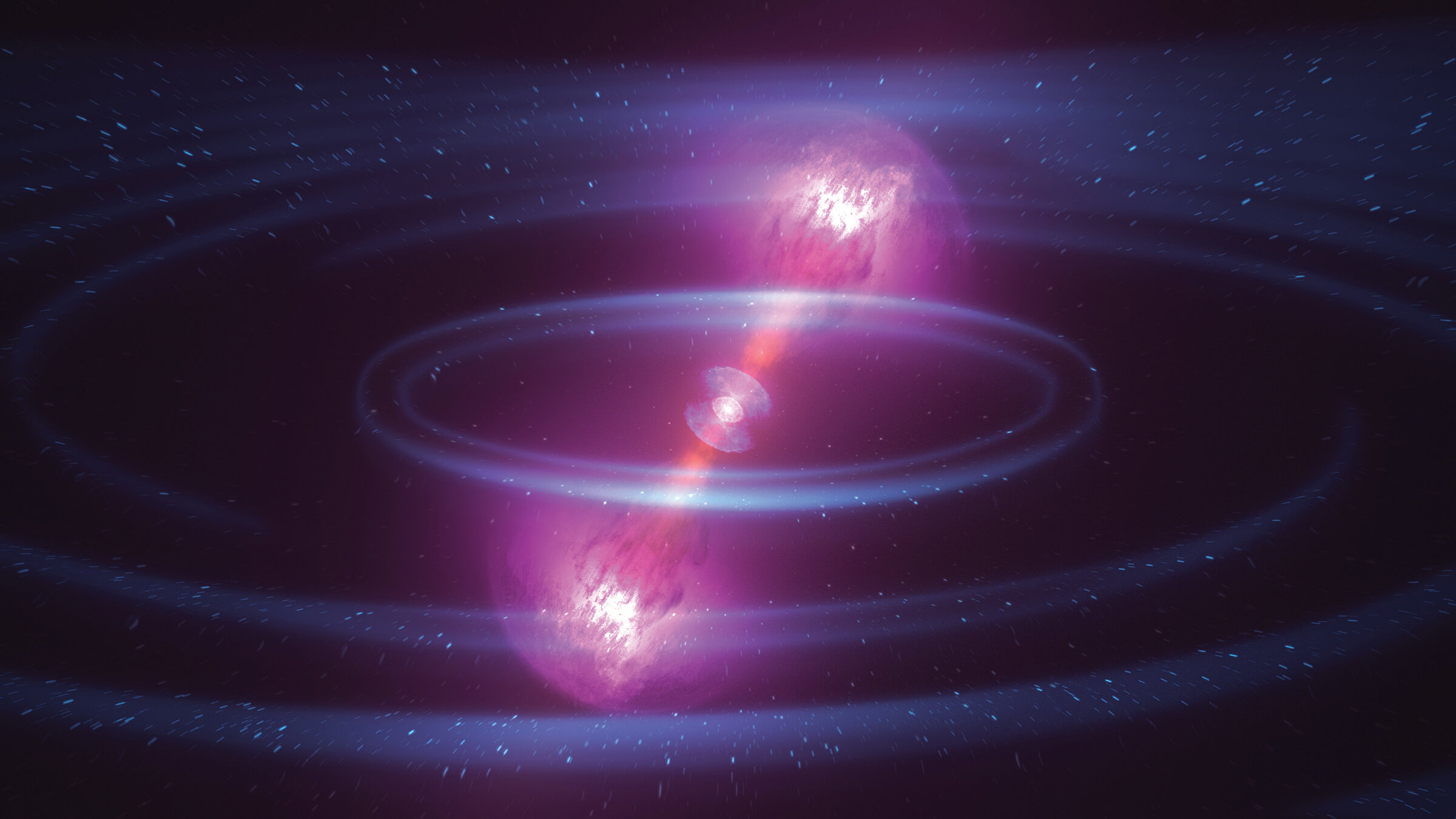
Multi-Messenger Astronomy
The DSA-2000 is designed to address two central goals of multi-messenger astronomy: identifying electromagnetic counterparts to compact-object mergers, and pulsar timing for GW detection. Multi-messenger astronomy, one of the NSF Ten Big Ideas, fuses GW and high-energy particle tracers of extreme astrophysical phenomena (e.g., strong-gravity and high-density environments) with electromagnetic observations.
Image: NASA
Compact Merger EM Counterparts
The DSA-2000 will be an essential and unmatched instrument for both discovery and EM-counterpart characterization of GW-detected BNS and NSBH mergers. With its ~10 deg² field of view, DSA-2000 will rapidly map the entire LVK localization regions to unprecedented depth, detecting BNS and NSBH mergers in the median ISM environments to the full O5 range. The resulting detection rate for DSA-2000 is tens (hundreds) per year for BNS (NSBH) mergers, establishing the prevalence of relativistic jets, identifying the role of the remnant in launching a jet, and using them to measure the NS equation of state (EoS). It will also detect the late time signature of dynamical ejecta, further constraining the EoS and the role of neutrino heating/cooling in the merger, and provide the best constraints of the environments of BNS and NSBH mergers, with implications for the progenitor channels. The DSA-2000 will play a complementary role to optical and infrared discovery efforts, particularly those of Rubin/LSST.
Left: Simulated radio light curves of a BNS merger at 190 Mpc for a median interstellar-medium (ISM) density (10⁻² cm⁻³). Also shown are the range of “red” (K-band – IR) and “blue” (r′-band – optical) kilonova lightcurves; 190 Mpc is the most optimistic range forecast for LIGO in the ongoing O4 observing run. Forecasts for the O5 run remain uncertain, with LIGO possibly extended to 240–325 Mpc. DSA-2000 (5σ / 4 hr) can detect both the median BNS jet and the median dynamical-ejecta signature for both O4 and O5. In many cases, due to the typically favorable inclinations of BNS and NSBH systems (median ~ 30 degrees), the DSA-2000 will be early enough to trigger follow-up observations with JWST. Right: Maximum distance at which BNS merger jets localized to ≤ 100 deg² can be discovered by the DSA-2000, SKA1-mid and ngVLA, as a function of inclination for a range of ISM densities. The putative ranges beyond O5 (e.g., Voyager – 2030s) and the range of future 3G detectors (2040s) are also shown. Due its enormous survey speed, DSA-2000 will be the most powerful radio discovery instrument for GW follow-up for the coming decades.
Pulsar Timing
On June 29, 2023, NANOGrav together with pulsar timing array (PTA) collaborations worldwide announced compelling evidence for a low-frequency (~ 10⁻⁹−10⁻⁷ Hz) GW background (GWB). The DSA-2000 will provide astrophysical interpretation of the GWB via a measurement of its strength at different frequencies, and the first identification of GWs from individual SMBHBs. The DSA-2000 PTA will be unparalleled in telescope-sensitivity, observing time, and wide frequency coverage, in order to achieve sensitivity to GWs from individual SMBHBs. Together with multi-wavelength observations, these results will provide critical tests of accretion physics, and of the little-understood mechanisms driving the formation of SMBHBs and coupling to their environments.
Left: Evidence for a low-frequency GW background (GWB) in NANOGrav data, using 68 millisecond pulsars (MSPs). The GWB is indicated by a predicted correlation (red dashed line) between timing variations for different pulsars (black points) that depends on the angular separation on the sky. Middle: The DSA-2000 will contribute approximately 2000 hr per year to PTA science. The DSA-2000 will more than compensate for the loss of Arecibo. Right: Sensitivity to GWs from individual SMBHBs. The dotted 15 yr curve is the current sensitivity, and the dashed curve and grey band indicate scenarios in 2036 without the DSA-2000. The solid curve indicates a scenario where current data are combined with 10 yr of DSA-2000 data. The stepped lines indicate GW strain values above which one, two, three and four SMBHBs respectively are expected (95% confidence). The predicted signal from a leading candidate SMBHB (3C66B) is shown. Based on the existing NANOGrav GWB detection, the DSA-2000 will detect GWs from a few tens of individual SMBHBs.
